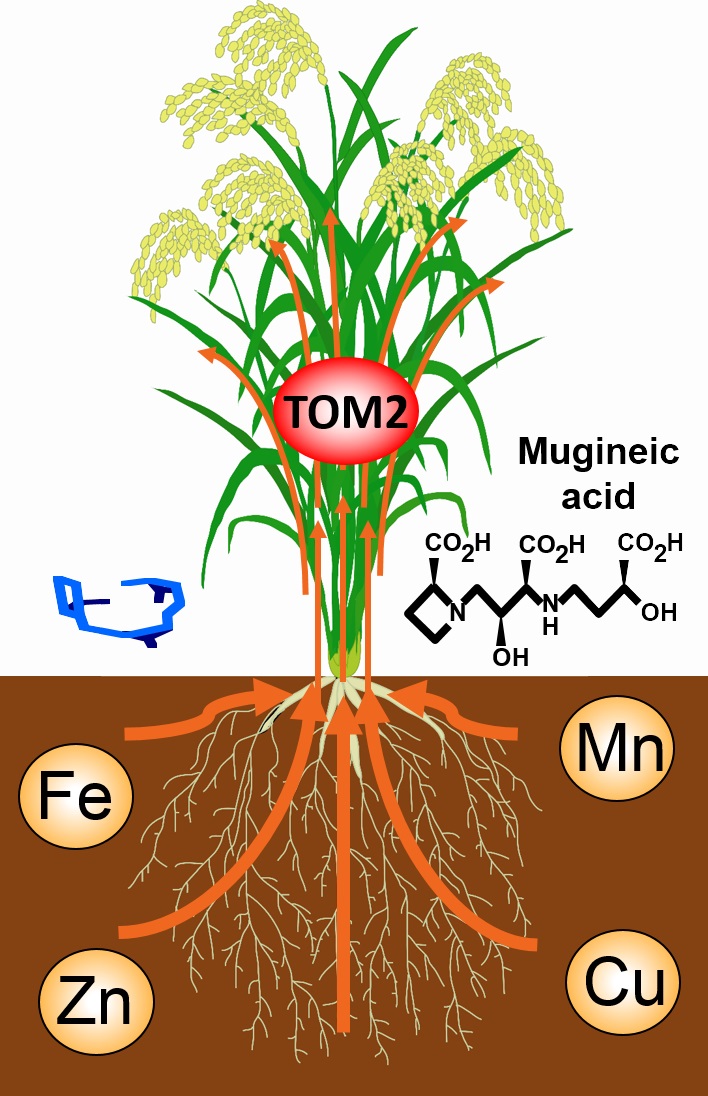Identification of a crucial metal transporter for plant growth TOM2 involved in metal translocation within plants


TOM2 is involved in metal translocation in the plant body
TOM2 is localized to tissues involved in metal translocation within the plant body. TOM2 may play a role in metal transport through secretion of mugineic acid family phytosiderophores. Plants that could not produce sufficient TOM2 showed dramatic growth defects, indicating that TOM2 is necessary for normal plant growth.
© 2015 Tomoko Nozoye.
Researchers at the University of Tokyo have demonstrated that TOM2, a cell membrane transporter protein, is involved in metal transport in the plant body. They found that repressing TOM2 causes growth defects, suggesting that TOM2 is necessary for normal plant growth. Modification of the TOM2 transporter protein may allow increased crop productivity and quality.
Plants require a variety of metals, which they acquire from the soil through their roots. Iron in particular is essential for growth and a broad variety of cellular processes from DNA synthesis to photosynthesis, but most iron in the soil is in forms that are not easily soluble in water and so cannot readily be taken up through the roots. Plants therefore secrete a variety of chemicals into the soil that bind with iron rendering it soluble, enabling the plant to reabsorb the dissolved iron complex. The Mugineic acid family phytosiderophores (MAs) are compounds that grasses secrete from their roots to acquire iron from the soil. In earlier research, the group showed that transporter of MAs 1 (TOM1) in rice and some other plants is involved in the secretion of MAs into the soil. MAs is involved in metal translocation in the plant. However, the molecular mechanism behind the transport of metals within the plant body has not been completely elucidated.
In this study, the research group of Project Researcher Tomoko Nozoye (concurrently lecturer at Meiji Gakuin University) and Project Associate Professor Hiromi Nakanishi at the University of Tokyo Graduate School of Agricultural and Life Sciences, Tohoku University Professor Nobuyuki Uozumi, Ishikawa Prefectural University Professor Naoko K. Nishizawa and their colleagues found that TOM2, another member of the TOM family, transports MAs to the exterior of the cell, is involved in metal transport in the plant body and is necessary for normal plant growth.
TOM2 was involved in the release of a MAs to the exterior of the cell, and was located in the cell membrane, indicating that the TOM2 protein is a transporter of MAs to the cell exterior. Expression of the gene TOM2, which encodes the TOM2 protein, was observed in the tissues involved in metal transport in the plant body, suggesting that TOM2 has an important role in MAs transportation within the plant body. Repression of TOM2 expression by RNA interference (RNAi) resulted in suppressing production of TOM2, showed growth defects and higher metal concentrations in the roots and shoots. “These results suggest that TOM2 may play a crucial role in the mobilization and utilization of metal accumulated in the exterior of cells through MAs secretion to render metal nutrients soluble and facilitate their transport to storage organs in the plant body,” says Project Researcher Nozoye. She continues, “Recent advances have shown that specialized plant membrane transporters can be used to enhance the yields of staple crops and to increase their nutrient content and resistance to environmental stresses, such as iron deficiency, a common agricultural problem. Characterization of the TOM2 protein is a significant step in advancing these efforts.”
Paper
, "The phytosiderophore efflux transporter TOM2 is involved in metal transport in rice ", The Journal of Biological Chemistry: 2015/10/2 (Japan time), doi: 10.1074/jbc.M114.635193.
Article link (Publication, UTokyo Repository)
Links
Graduate School of Agricultural and Life Sciences
Department of Global Agricultural Sciences, Graduate School of Agricultural and Life Sciences
Institute of Liberal Arts, Meiji Gakuin University (Japanese)
Department of Biomolecular Engineering, Graduate School of Engineering, Tohoku University
Research Institute for Bioresources and Biotechnology, Ishikawa Prefectural University (Japanese)






